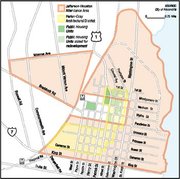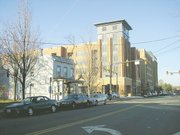Nowhere in the Parker Gray neighborhood is the pace of change more palpable than the corner of Pendleton Street and North Henry Street. As the daily crush of Route 1 traffic whizzes south along Henry through the regional traffic corridor, an ultra-modern looking six-story tower is rising on the southwest corner of the intersection. On the other side of the street, as if stuck in a time warp, is a two-story townhouse from the early 20th century. Its subtle detailing is all but lost in the rush to modernize the neighborhood with large-scale condominiums.
"You’ve got the old neighborhood on one side of the street, and then you’ve got Rosslyn on the other side of the street," said Fred Herbert, a longtime resident of Alexandria who lives in a rented room in the old building at the southeast corner of the intersection. "I think it’s ridiculous to put this skyscraper here next to these old townhouses."
Herbert said he was not aware that the City Council had recently approved a Starbucks that would soon open in the ground-level retail on the other side of the street, and he said he probably wouldn’t find himself sipping a latte there. As he craned his neck to see the top of the tower across Henry Street, he wondered what would become of Parker Gray — Alexandria’s historically black neighborhood, which once revolved around the now-demolished Parker Gray High School. Yet while Herbert said he felt like much of the history was becoming lost among the new high-density structures, other longtime residents said they hoped the radical transformation now taking place in their neighborhood would be a positive transformation in the long run.
"I wish more of my contemporaries had returned to the neighborhood," said Juvenile and Domestic Court Judge Nolan Dawkins, who lives in the same Parker Gray house he grew up in. "When you look at the scale of a lot of these new buildings, it certainly dwarfs the old townhouses. On the other hand, change is not always a bad thing."
THE BLOCKS BETWEEN the Braddock Road Metro station and Washington Street are, in many ways, a blank canvas waiting for a new landscape. Decisions made in the 1940s and 1950s to concentrate public-housing units in this area are now widely criticized, with modern city officials preferring a "scattered site" approach that mixes market-rate units with public housing. The city’s housing authority has already slated several of Parker Gray’s public-housing units for redevelopment with the sale of the expensive land paying for redevelopment of public-housing units in other parts of the city. In October, the City Council approved a plan that will finance the redevelopment of Arlandria’s Glebe Park using money from the sale of Parker Gray’s James Bland project, reducing the number of public-housing units at Bland from 194 to 134.
"James Bland is a cash cow," said Connie Ring, vice chairman of the authority, after the vote. "At this point, we have a promise from the city that they will try to find sites to relocate the public-housing units that will be reduced from Glebe Park and James Bland."
One reason that city officials are eager to move from concentrated public housing to a scattered-site approach is the amount of crime that is attracted to the blocks surrounding Parker Gray’s public-housing units. In the last two years, the neighborhood has incurred homicides in the 400 block of North Patrick Street, the 800 block of Montgomery Street, the 900 block of North Henry Street and a double murder in the 800 block of North Patrick Street. The most recent murder in the neighborhood happened in the 400 block of North Columbus Street last September, when police found the body of a Maryland man who had been shot in the head.
"The majority of homicides committed in Alexandria are against persons known to each other and do not necessarily pose a substantial increase in risk to the general public," wrote Police Chief David Baker in a memorandum after City Councilman Rob Krupicka called for an official response to the spate of violent crime in the area. "Homicide is a Part One crime that is of great concern to the Police Department, and we are working diligently to identify those responsible for the most recent incident in the 400 block of North Columbus Street. However, there is no indication that this event is cause for citizens to feel less safe."
For many longtime residents of the neighborhood, the idea that the criminals are "known to each other" isn’t a reason to declare success in Parker Gray. Sarah Becker, who moved to the neighborhood in 1987, said that she felt the Police Department has been successful in reducing the level of crime over the past 20 years. In the 1990s, she worked with police as president of the Inner City Civic Association president to help reduce crime in the neighborhood. Yet she said the six recent murders over the last two years have illustrated that more needs to be done. Chief Baker’s statement about the murders being against "persons known to each other," she said, was not necessarily a move in the right direction.
"To me, that’s an unproven statement," said Becker, noting that the police have yet to make an arrest for the September murder on Columbus Street. "The real question is: What draws people to this area?"
OVER THE LAST 30 years, the demographics of the Parker Gray neighborhood have changed dramatically as land values have soared, longtime residents have aged and new development has claimed industrial swatches of land. Although the area was a historically black enclave in Alexandria, the 2000 Census data indicated that whites had outnumbered blacks in Parker Gray just as the real-estate boom saw an explosion of assessments. While average value of a single-family home in the area was $196,869 in 2000, that average rose to $466,287 in 2005.
"These facts about the population, especially the loss of African-American families and the influx of higher-income residents, tells us that the composition of the area is changing and that the demand for land for high end residences is increasing," noted a city Planning Department document from September 2006.
Meanwhile, a larger story was playing out in the streets of Parker Gray — one many neighborhood residents argue is more significant than the racial shift. In the 1970s, nearly a third of the neighborhood’s population lived in poverty. But by 2000, city records show, less than one fifth of the population in Parker Gray lived below the poverty level. During that same period of time, the number of families with children declined dramatically — with city records showing 410 married couples with children in 1970 to 123 married couples with children in 2000. The vast majority of parents who remained abandoned the local elementary school after years of failing test scores, constant administrative turnover and federally imposed sanctions.
"I’d like to see more obligation and commitment to the neighborhood," said Bill Campbell, president of the Jefferson-Houston Elementary School’s parent-teacher association. "It’s kind of a chicken-and-egg thing. If we could get those parents to keep their kids at Jefferson-Houston, we would have more involvement in the school."
In October, the School Board voted to indefinitely suspend Jefferson-Houston’s "arts focus," which sent the school’s teachers to a training program at the Kennedy Center known as Learning Education Through the Arts. Administrators said that the professional development opportunities for teachers at Jefferson-Houston — many of whom are new to the school — could be more useful if efforts were directed at core subjects such as math or reading. Since the focus was created in 2000, the student population at Jefferson-Houston dropped from 486 in 2000 to 281 last year. During that same amount of time, the number of students qualifying for free or reduced lunch — a designation tied to federal poverty guidelines — has increased from 77 percent to 83 percent. This year, 53 percent of the school’s students live in public housing. Earlier this year, both federal and state officials imposed sanctions after another year of failing standardized test scores.
"At this point, the important thing is that we have a strong administrative team at the school and a galvanized community that is committed to improving this school," said School Board member Sheryl Gorsuch. "The next step we need to take is to engage the community and find out what parents want."
ENGAGING THE COMMUNITY is about to take a new direction in Parker Gray. Last month, the Inner City Civic Association — which includes most of the area near the Braddock Road Metro station — voted a new slate of leadership that includes an outspoken member of the community as its new president. Leslie Zupan, creator of a popular neighborhood blog known as "The Parker Gray Growl," will now head the civic association at a time when the area’s "small-area plan" will be moving through the final stages of approval at City Hall.
"We need to do a better job of managing the density in this area," said Zupan, adding that recent approved developments in the neighborhood will increase traffic congestion and parking woes. "Even people who live near Metro stations have cars, and they are going to be taking their cars out of the garages."
Zupan said that she would like to rejuvenate the civic association by bringing more people into the fold and carefully identifying the issues that are of concern in the neighborhood. One of the ways she hopes to do this is by using her Web site, in which residents can anonymously comment on a host of issues. Since launching the blog in 2005, Zupan has assumed a persona known as "the Cranky One," referring to the small-area planning process as a "death march" and the use of James Bland windfall to pay for Glebe Park "economic colonialism." But since assuming a leadership position, she has softened her rhetoric in an effort to represent the residents who live in the neighborhood without histrionics.
"The blog has been a good barometer," she said. "But it’s not the only barometer."
Zupan said she would like to see developers invest more in the neighborhood, beefing up the infrastructure and contributing toward creating a new public park in Parker Gray to increase the open space in the increasingly dense area. She said she would like to see city officials engaged in efforts to improve the streetscape by adding more seasonal plantings, widening the sidewalks and undergrounding utilities in a fashion similar to the Old Town neighborhood. As the small-area plan moves forward, she said she would like to see design guidelines in the plan so residents and developers will have a level of expectation about the kind of architecture that can be built in Parker Gray.
"I lean toward the old architecture, but I’m also interested in seeing new fresh designs," said Zupan, an IT professional for a Washington-based nonprofit organization. "It doesn’t seem like the planning process here has been as visionary as it was in Arlington."


